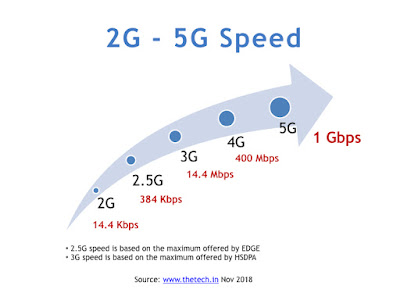2G was for text / phone calls, 2.5G was for emails, 3G was for web, 4G was for video and 5G is for use cases that we can't possibly imagine. (Also read: 4G vs. 5G)
Some 5G use cases that are being explored are:
- Enhanced Mobile Broadband (eMBB) - With data speeds of 1Gbps, 5G is suited well for enhanced mobile broadband. Enhanced Mobile Broadband services are accessed by consumers in places such as trains, public transport systems, shopping malls and airports. There is an ongoing debate on whether 5G network would kill WiFi. eMBB uses WiFi to provide coverage to users and would use 5G network for getting the backhaul connectivity to Internet. eMBB will complement and may increase the penetration of WiFi coverage.
- Fixed Wireless - Verizon is the first 5G wireless service provider in the world to offer Fixed Wireless services to customers. Verizon announced that 5G coverage will be available to 4 different 5G cities, as part of the initial launch. Fixed Wireless services eliminate the need to dig the road and lay cables in the last mile to provide Internet connectivity to homes. It also reduces the cost of dispatching a technician to customer homes. (Read: Why is there a lot of buzz on Fixed Wireless Services?)
- Robotic Surgery - 5G supports ultra low latencies (1ms or less), which makes it ideal for latency sensitive use cases such as Robotic Surgery. Robotic Surgery allows a doctor to remotely diagnose a patient and perform surgery. This allows hospitals to provide quick treatment to patients, saving lives and money. Technologies such as Multi-access Edge Computing (MEC), are helping service providers to improve the latencies of 5G network, to support use cases such as Robotic Surgeries.
- Smart Cars - Smart Cars consume a lot of bandwidth and at the same time, require quicker responses from the network. A fast moving car cannot wait for seconds to decide whether the object crossing the road is a vehicle or a human. Most of the intelligence of Smart Cars reside in the Cloud and the car requires continuous connectivity to the network. 5G supports higher bandwidth and lower latencies which enables use cases such as Smart Cars.
- Virtual Reality / Augmented Reality (AR/VR) - Imagine visiting a zoo or playing soccer with your friends across the continent, from your living room. 5G supports VR/AR use cases enabling consumers to play high definition games or consume high quality entertainment.
- Private Wireless Network - Enterprises today rely heavily on WiFi for ubiquitous access to Internet and Intranet, from within the campus. WiFi also helps Enterprises to configure and manage policies for users. 5G allows Enterprises to install and manage a secure Private Wireless Network for its users. (Also read: Will 5G kill WiFi?)
- Live TV - The increase in the bandwidth and the reduction in latency allows service providers to stream Live Television on top of 5G network. SK Telecom demonstrated the broadcasting of live TV during the beginning of 2019.
- Holographic Call - Vodafone UK demonstrated the first live holographic call using 5G. Holographic call allows you to create live interactions with someone who is geographically miles apart. It saves travel costs and time for Enterprises and Consumers.
5G Network Slicing allows service providers to support all of these different use cases using the same network infrastructure. With service providers actively deploying 5G services across the globe, we can expect to see many more 5G use cases sprouting in the industry.








No comments:
Post a Comment